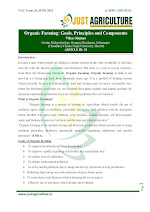Dark reaction or Blackman’s reaction
or Path of carbon in photosynthesis
This
is the second step in the mechanism
of photosynthesis. The chemical processes
of photosynthesis occurring independent of light is called dark reaction. It takes place in the stroma of chloroplast. The dark reaction
is purely enzymatic and it is slower than the light reaction. The dark reactions occur also in the presence
of light. In dark reaction,
the sugars are synthesized from CO2. The
energy poor CO2 is fixed to energy rich carbohydrates using the energy rich compound, ATP and the
assimilatory power, NADPH2 of light reaction. The process is called carbon fixation or carbon
assimilation. Since Blackman demonstrated the
existence of dark reaction, the reaction is also called as Blackman’s reaction. In dark reaction two types
of cyclic reactions occur
1.
Calvin cycle or C3 cycle
2. Hatch and Slack pathway
or C4 cycle
Calvin cycle or C3 cycle
It is a cyclic reaction occurring in
the dark phase of photosynthesis. In this reaction, CO2 is converted into sugars and hence it is a
process of carbon fixation. The Calvin cycle
was first observed
by Melvin Calvin in chlorella, unicellular green algae. Calvin was awarded
Nobel Prize for this work in 1961. Since the first stable compound in Calvin
cycle is a 3 carbon compound (3
phosphoglyceric acid), the cycle is also called as C3 cycle. The reactions
of Calvin’s cycle occur in
three phases.
1. Carboxylative phase
2. Reductive phase
3. Regenerative phase
1.
Carboxylative phase
Three molecules of CO2 are accepted by 3
molecules of 5C compound viz., ribulose diphosphate
to form three molecules of an unstable intermediate 6C compound. This reaction is catalyzed
by the enzyme, carboxy dismutase
3 CO2 + 3 Ribulose diphosphate ---------------- 3 unstable intermediate 6 carbon compound
*With the help of Carboxy dismutase
The three molecules of the unstable 6 carbon compound are converted
by the addition of 3 molecules of water into six molecules
of 3 phosphoglyceric acid. This reaction is also catalyzed by the enzyme carboxy mutase.
3 unstable intermediate 6 C compound + 3 H2O ---------- 3 phosphoglyceric acid
3 phosphoglyceric acid (PGA) is the first
stable product of dark reaction
of photosynthesis and since it is a
3 carbon compound, this cycle is known as C3 cycle.
2.
Reductive phase
Six molecules of 3PGA are phosphorylated by 6
molecules of ATP (produced in the light
reaction) to yield 6 molecules of 1-3 diphospho glyceric acid and 6 molecules
of ADP. This reaction is catalyzed by the
enzyme, Kinase
Kinase
3 Phospho glyceric acid + ATP ----------------- 1,3 diphospho glyceric acid + ADP
3. Regenerative phase
In
the regenerative phase, the ribose diphosphate is regenerated. The regenerative phase is called as pentose phosphate pathway or hexose
monophophate shunt. It involves the following steps.
1. Some of the molecules
of 3 phospho glyceraldehyde into dihydroxy acetone
phosphate. Both 3 phospho glyceraldehyde and dihydroxy acetone phosphate
then unite in the presence
of the enzyme, aldolase to form fructose, 1-6 diphosphate.
2. Fructose 6 phosphate is converted into fructose 6 phosphate in the presence of phosphorylase
3.
Some of the molecules of 3 phospho
glyceraldehyde instead of forming hexose sugars are diverted to
regenerate ribulose 1-5 diphosphate
4. 3 phospho
glyceraldehyde reacts with fructose 6 phosphate in the presence of enzyme transketolase to form erythrose 4
phosphate ( 4C sugar) and xylulose 5 phosphate(5C sugar)
5.
Erythrose 4 phosphate combines with dihydroxy
acetone phosphate in the presence of the enzyme aldolase
to form sedoheptulose 1,7 diphosphate(7C sugar)
6.
7. Sedoheptulose phosphate reacts with 3 phospho glyceraldehyde in the presence of transketolase to form xylulose 5 phosphate and ribose 5 phosphate ( both % c sugars)
8. Ribose 5
phosphate is converted into ribulose 1, 5 diphosphate in the presence of enzyme, phosphopentose kinase and ATP. Two
molecules of xylulose phosphate are also converted
into one molecule
of ribulose monophosphate. The ribulose monophosphate is phosphorylated by ATP
to form ribulose diphosphate and ADP, thus completing Calvin cycle.
In the dark reaction, CO2 is fixed to carbohydrates and the CO2 acceptor ribulose
diphosphate is regenerated. In Calvin cycle, 12 NADPH2 and 18
ATPs are required to fix 6 CO2 molecules into one hexose sugar
molecule (fructose 6 phosphate).
Schematic diagram of light reaction
and Calvin cycle





















0 Comments